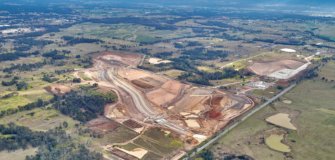What’s the Future for Hire in the Construction Industry?
Martin Sinclair Jan 04

We asked Jon Davies, CEO of the Australian Constructors Association, to share his thoughts on creating a more diverse, collaborative, sustainable and productive Industry.
1. What do ACA members view as the key drivers for sustainable construction?
The Australian Constructors Association (ACA) believe there are three pillars to a sustainable construction industry: a positive industry culture, equitable and aligned commercial frameworks and sufficient capability, capacity and skills. All three pillars are interlinked and improvement in one requires improvement in all. As an example, adversarial commercial frameworks negatively impact on culture and a positive industry culture is a key factor in attracting people into the industry. Building on these three pillars and recognising the significant role the construction industry has in supporting net zero targets, in 2022 ACA updated its strategic plan to reflect the need to view these pillars through an environmental lens. Hence, stakeholders are now starting to see greater involvement from ACA in initiatives also aimed at improving the environmental sustainability of the industry.
2. How important is netzero as a strategic imperative to the construction industry?
Climate action is valued by investors, being prioritised by customers which is changing buying decisions, and informing career choices. Without doubt, net-zero is a strategic imperative. As an industry, we are here to build communities for the long term and committed to developing sustainable infrastructure for future generations. Infrastructure influences 70% of Australia’s emissions and a collaborative and coordinated response is required. With other industry stakeholders the ACA is working on actions that accelerate the decarbonisation of Australia’s infrastructure. Our ultimate aim will be to meet or exceed the net-zero emissions targets set for 2030 and 2050. The current record investment in infrastructure creates exciting opportunities for the construction industry to step up and deliver quadruple bottom line outcomes. Technology and innovation will have a key role to play in the transition, along with clear government policy that supports sustainability considerations and forward-thinking planning. We have our sights firmly set on making an impact together.
3. What can Tier 1 contractors teach the rest of the industry about sustainability?
The construction industry operates as a complex system that cannot easily be broken down and categorised. Projects are built by many interconnected teams of people fed by long supply chains that are ultimately managed by contractors. It therefore stands to reason that to improve project outcomes, there needs to be a focus on optimising the system as a whole and not just one component. That’s why everyone has a role to play. The ACA recognises the industry is facing competing pressures in trying to manage costs and timelines with multiple suppliers and subcontractors and focus on reducing our carbon footprint. We are committed to changing the culture of the industry and working collaboratively with clients and industry partners to improve outcomes. An improved industry culture will lead to cascading improvements throughout the whole complex system of the construction industry.
4. What do you view as the main advantages to using ‘hire’ over ‘owned’ fleet equipment?
The obvious answer is that it frees up the balance sheet to invest in growing a business. Going forward, there could be significant additional benefits in terms of being able to quickly capitalise on advances in technology, particularly in respect of emissions reductions.
5. What will ACA members be looking for from Hire companies in the future?
The construction industry works best when it works together. We have to move away from the idea that construction is a zero-sum game with winners and losers. We recognise the need for increased collaboration with all industry stakeholders, including our supply chain, so we can find better ways of working efficiently, flexibly and with reduced impact on the environment. That’s when everyone wins.
6. What are your top priorities in the coming 12 months?
Industry is facing several headwinds and we recognise the need to be agile and respond to issues as they arise. That’s why over the next 12 months we are focusing our efforts on addressing the following key areas: input price escalation risk, industry culture and trust, productivity, environmental sustainability, and market capability / capacity. ACA will be undertaking a series of strategic sprints to achieve measurable outcomes around these key areas that we believe will help the industry weather the current storm. One of these strategic sprints involved the development of the report ‘Construction cost inflation—ways to address an escalating issue.’ Through this report we are calling on government to take action, in respect of current and future contracts, to ensure contractors are not left out-of-pocket for what is an issue that is well beyond their reasonable control. The industry is seeing examples of price rises over a 12-month period of up to 70 per cent and yet clients continue to expect fixed prices. The industry cannot continue to bear the cost of these steep price increases—some costs will need to be passed on to halt the growing trend of insolvencies. ACA has met with government to discuss the recommendations in the report to help the industry become more financially sustainable and properly focus on important issues such as improving productivity, sustainability and innovation.In addition to our strategic sprints, ACA is continuing to progress longer-term collaborations with government and other industry stakeholders through initiatives such as the Construction Industry Leadership Forum and Construction Industry Culture Taskforce. Through these government and industry collaborations, we are working to improve procurement practices and the culture of the industry through the introduction of a new Culture Standard. ACA’s key policy initiative is the Future Australian Infrastructure Rating (FAIR). We believe this is the long-awaited disrupter. FAIR pinpoints the Federal Government in its role as a major source of infrastructure funding as being able to significantly promote reform. FAIR provides a way for the Federal Government to do this without the need for significant change to existing project governance/funding frameworks or prescribing how projects are delivered. A simple way to do this would be to include the initiative in the next iteration of the National Partnership Agreement.FAIR is designed to rate federally funded projects on how well they performed against a range of key reform areas including increased participation. Specifically, it will incentivise adoption of the Culture Standard to ensure women have equal opportunities and equal pay in construction, and improve the mental health and wellbeing of the industry’s workers. All proponents seeking federal funding for projects would be required to submit details of how they intend to achieve improved project outcomes and on completion, they would be held to account.
7. What can HRIA members do to better help the construction industry?
Together, we need to look at ways to promote efficiency and productivity while reducing our impact on the environment. The construction industry is fragmented and too often operates on transactional relationships rather than partnerships. We recognise that we are all complicit when it comes to the current situation, however we need to leave behind the baggage of history if we are to achieve the transformational change that industry needs. We call on HRIA members to join us on the journey towards creating a more diverse, collaborative and productive industry that minimises its impact on the environment and is an industry of choice for the next generation of workers.










